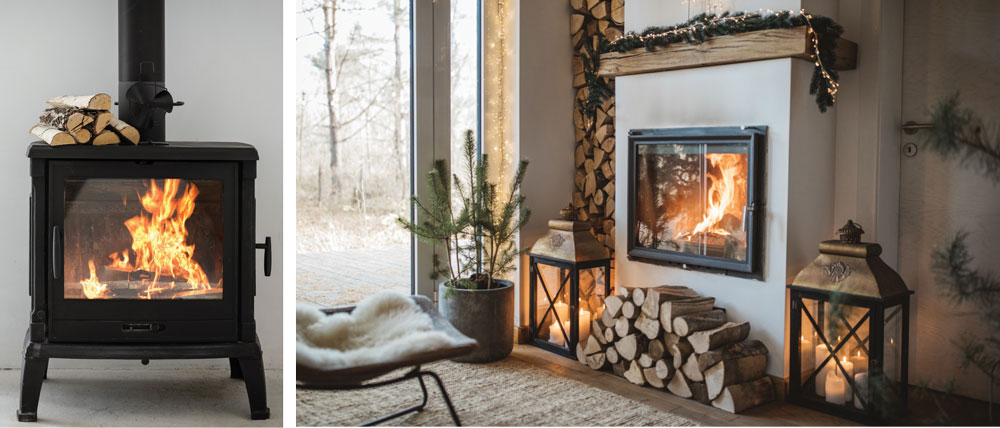HEARTH & SOUL
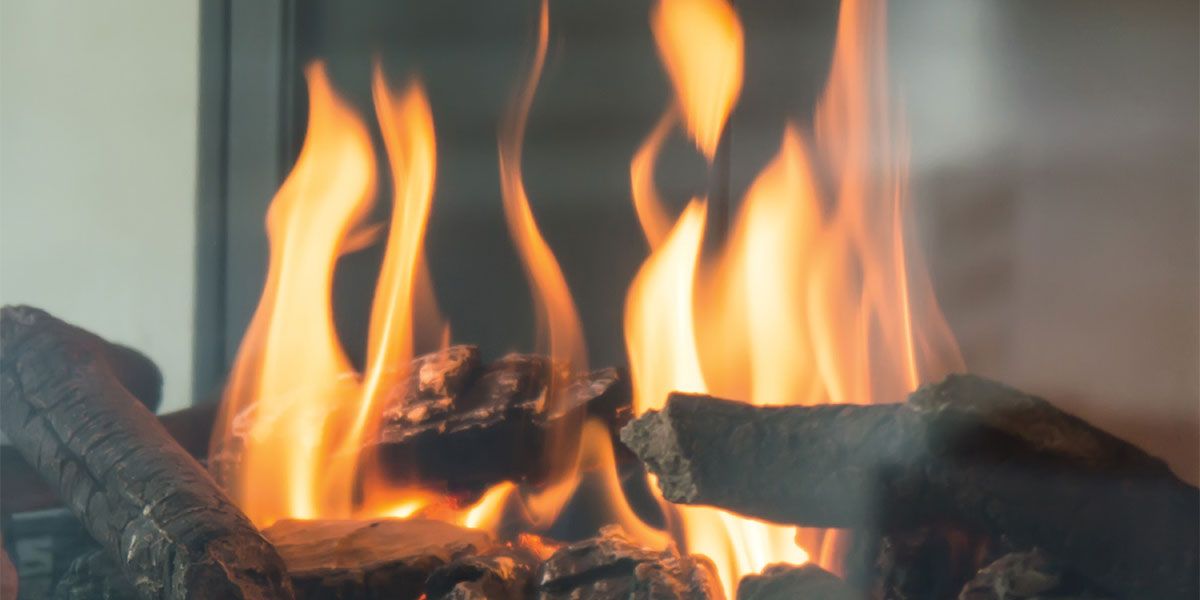
TODAY’S FIREPLACES CENTER ON STYLE AND EFFICIENCY
Cozying up to a toasty fire while the cold wind whirls around outside is the essence of the holiday season. Even if you rely on a central heating system, it’s hard to feel at home without a fireplace. If you’re planning to build in the new year, house hunting or kicking off a wish list of upgrades, local professionals can help you choose the right hot spot for your family.
Fuel factor
Wood or gas? It’s a never-ending debate in the fireplace industry, but no matter who you talk to, innovations have greatly improved efficiency on both sides.
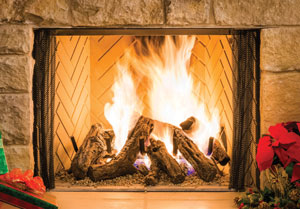 To some homeowners, it’s about tradition: The hearty, smoky smell and crackling sounds of a wood fire awaken the senses. “There’s something about an open, roaring fire in the fireplace that people will always be drawn to,” says Ben Briscoe, vice president of Black Goose Chimney Service. Although his company sells, installs and services wood and gas fireplace options all year long, he says many of their customers prefer the self-sufficiency of solid fuel: “There’s always the fear of a power outage, and they want to be the one warm house on the block.”
To some homeowners, it’s about tradition: The hearty, smoky smell and crackling sounds of a wood fire awaken the senses. “There’s something about an open, roaring fire in the fireplace that people will always be drawn to,” says Ben Briscoe, vice president of Black Goose Chimney Service. Although his company sells, installs and services wood and gas fireplace options all year long, he says many of their customers prefer the self-sufficiency of solid fuel: “There’s always the fear of a power outage, and they want to be the one warm house on the block.”
Today’s models have come a long way from our grandmother’s old-timey wood stove, he says. A heavily regulated part of the heating industry, manufacturers of freestanding wood stoves and wood-burning fireplace inserts (a completely sealed unit placed into an existing fireplace structure) have made big strides in bringing cleaner-burning models and striking designs to market. It used to be that the larger the stove, the more heat. But smaller units are now holding a consistent burn for 12+ hours with a full load of wood, and many models can stretch that to 18-22 hours.
“It means you’re burning a lot less wood for a lot more heat — and there’s no heat quite like wood heat.”
Today’s models are also adding a ton of character along with the comfort.
There’s something mesmerizing about gazing at flames, and you can do that even better now with stoves and inserts that feature clear, ceramic glass panes on the loading door and a specially engineered “air wash” system that forces air over the inside of the glass to keep it from blackening with soot. There’s even a modern design that features glass on three sides.
Wood-burning fireplace inserts come in an array of finish accents, from ornate nickel and brass to enamel. For a luxurious look, Black Goose offers a glossy, chestnut brown-enameled insert, one of Briscoe’s personal favorites.
“Not only are these products utilitarian, with all the heat you need and more, but they are very attractive to look at,” he adds. “When you install something like that, the perfect setting is a large grand area that needs a new focal point — you want people to walk in and take notice.”
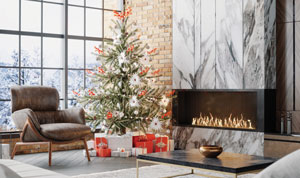 Briscoe says they have installed wood-burning appliances in homes of all sizes and styles. But when tradition doesn’t win out and convenience is a top priority, there’s a place for gas options too. He says they have many offerings in “direct vent” gas appliances — fully gasketed and sealed units with attractive glass fronts that often run on thermostatic control with a remote. “Direct vent” refers to a system where air is pulled in from outside the home and the exhaust — all the by-products of combustion — are directly routed out of the home.
Briscoe says they have installed wood-burning appliances in homes of all sizes and styles. But when tradition doesn’t win out and convenience is a top priority, there’s a place for gas options too. He says they have many offerings in “direct vent” gas appliances — fully gasketed and sealed units with attractive glass fronts that often run on thermostatic control with a remote. “Direct vent” refers to a system where air is pulled in from outside the home and the exhaust — all the by-products of combustion — are directly routed out of the home.
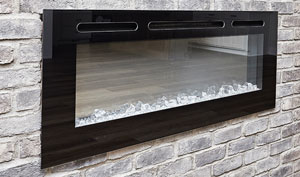 Laura Borel, head of sales and marketing for Francis Oil & Propane, says direct vent gas fireplaces are becoming the norm. With their eco-friendly reputations, they are highly recommended for those with pets or allergies. The systems can be built-in for new construction or made to fit into an existing fireplace.
Laura Borel, head of sales and marketing for Francis Oil & Propane, says direct vent gas fireplaces are becoming the norm. With their eco-friendly reputations, they are highly recommended for those with pets or allergies. The systems can be built-in for new construction or made to fit into an existing fireplace.
No chimney? No problem!
Installing a direct vent gas fireplace is an alternative if you don’t have a chimney but want an efficient heating appliance along with the ambiance of a large, traditional fireplace. Vents can be easily routed through an exterior wall and aren’t greatly affected by drafts and air pressure changes, so the heat isn’t escaping like it does through a traditional fireplace chimney. A single double-walled pipe can both pull in air from the outside and expel exhaust outside as the unit radiates heat right into your room. Ventless gas logs can also be installed without a fireplace but have some safety restrictions.
Since the invention of the direct vent, “a fireplace is possible for anyone,” Borel says. “We can always run gas lines and get them going with propane.”
If your current heating system works well but you long for a decorative fireplace, another option is to go electric. There’s no mess or maintenance; you’re essentially running a fancy light show and a supplemental heater. Electric fireplaces are generally much cheaper, require no installation, and are safe to the touch, so there’s no worry with young, curious hands. Some high-end models have very realistic flames, and you can even change the color with a remote, from a traditional orange flame to blue or purple. Electric fireplaces are never meant to be a primary heat source, but they can take the chill off. Many have separate switches for heat and lights, so you can switch on the “flames” even in the summer.
Going linear
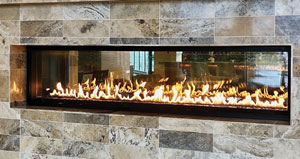 Modern fireplaces are keeping up with the minimalistic, sleek trend in home design today, quite literally flipping the traditional style on its side. Rectangular or “linear” fireplaces, usually installed as a built-in, have become trendy centerpieces or “impact walls” as designers call them. While they look luxurious, their functionality has just as much appeal.
Modern fireplaces are keeping up with the minimalistic, sleek trend in home design today, quite literally flipping the traditional style on its side. Rectangular or “linear” fireplaces, usually installed as a built-in, have become trendy centerpieces or “impact walls” as designers call them. While they look luxurious, their functionality has just as much appeal.
Borel says there are linear inserts that range from 48 to 72 inches wide. Some popular designs are “see-through” styles, where you can walk around the entire fireplace in the same room or view one side from your living room and the other side from your patio.
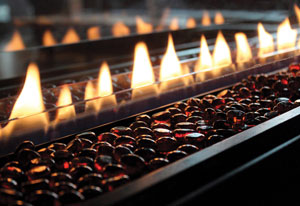 Trends
Trends
Homeowners are also embracing other modern features, from adding a bed of river stones or crushed glass to getting creative with fronts and liners.
Borel says one trend is to add dimension to the liner option with stone or brick; the herringbone pattern and using larger bricks are also trends becoming more popular. She’s also seeing a break from the usual black interior and a move toward a warmer gray or beige. She’s getting requests for a black glass mirror-like liner for an elegant look where “you can really see the flames dancing.”
Homeowners are also ordering more decorative fronts. “Whatever your style is, there’s a front for you — from rustic and Western to more modern,” she says.
And whether you prefer the vented or ventless versions, gas logs are also getting more attractive. Borel says she’s seeing more birch logs and the option to add glowing embers throughout the burner.
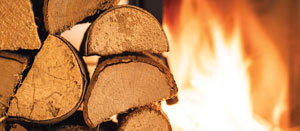 Making the switch
Making the switch
Sometimes our families need change. Wood may have been your choice when you moved in but you’re considering switching to gas for the convenience.
Borel says her customers are converting to gas, either adding a set of gas logs or an entire gas insert “because it’s cleaner, it’s cost effective and it’s safer. Gas logs are a great backup source of heat and add ambiance to a room.”
Even those who are apprehensive about gas usually find it worthwhile to make the switch, she says.
“We educate our customers on how to safely use their appliance. They have to trust it. It’s very regulated; there are rules and laws in the industry. That’s why it’s important for them to choose a company that both sells and services the appliance — we can help them choose the right one for them. Speaking to a professional and having someone come out to your home can head off those issues.”
But if you fall in the camp where you miss the authentic wood fireplace you grew up with and your new home has a gas unit that you don’t feel comfortable using, there is an option to revert back to wood.
Briscoe says he’s actually seeing a lot of people make this change, especially with how efficient wood-burning stoves have become. His company deals heavily in the restoration of older fireplaces to burn wood. The process begins with a thorough Level 2 inspection (which he suggests for every new home inspection) and continues with annual maintenance.
“The chimney is always the most neglected portion of the home … Unless you have it regularly maintained, there’s a 99% chance you have something that needs checked.”
If you want the best of both worlds, some of the country’s most high-end fireplace models are just coming onto the scene with the option for the homeowner to convert from wood to gas and vice versa themselves — whenever they want.
On a cold winter day, a fire always beckons. As you explore the diverse range of fireplace options available today, you may just warm up to one that is the perfect fit for your family. ✦
“linear” fireplaces, direct vent gas fireplace, fireplaces, freestanding wood stoves, fuel, gas, Wood, wood stove, wood-burning fireplace insert
